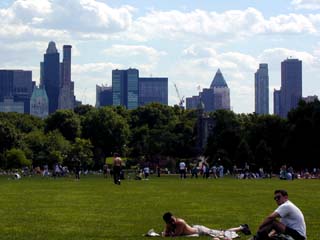Where else in Central Park can you have an alfresco dinner on a luxurious carpet of emerald green grass and listen to a world-renowned symphony or opera? Only on the newly-restored Great Lawn. Every summer the New York Philharmonic and the Metropolitan Opera each give two free performances. On those nights a carpet of picnic blankets covers the lawn and the Manhattan skyline defines the most famous Park view in the world. During the daytime a livelier tempo dominates, as Park users enjoy eight softball fields or play soccer, basketball, and volleyball.
Although integral to the lives of many New Yorkers and definitive in many ways of Central Park, the Great Lawn was not included in the Greensward Plan; it is the single largest landscape feature in the Park that was not part of Olmsted and Vaux's original design. One hundred and fifty years ago it was a 33-acre rectangular receiving reservoir holding 180 million gallons of drinking water piped in from the Croton River in Westchester County. The reservoir predated Central Park and required Olmsted and Vaux to design this pastoral and naturalistic landscape around its hard-edged rectangular shape.
The Croton Reservoir (completed in 1842) was adjacent to a receiving reservoir, irregular in outline, which is now named the Jacqueline Kennedy Onassis Reservoir. A 1917 plan for a new water tunnel retained the original reservoir – but rendered the Croton Reservoir obsolete. An extensive public debate over its use ensued, with suggestions ranging from sunken gardens to sports stadiums. Starting in 1931, the City filled in the Croton Reservoir using, among other material, stones from the building of Rockefeller Center. A 13-acre oval lawn took the Reservoir's place with a small pond at its southern end and two playgrounds at the northern end. In the 1950s eight ballfields were added. Within time the Great Lawn, as it was called, became the venue for some of the City's biggest outdoor events including the Paul Simon concert, Disney's June 1995 preview of the movie "Pocahontas," and a papal mass in October 1995 with Pope John Paul II.
Heavy use of this popular and central site took its toll. By the 1970s the Great Lawn was called the "Great Dustbowl," with winds whipping up dry dirt from its compacted surface. A major renovation in 1996-98 rescued the Great Lawn from New York's tough love. Working within the engineering constraints of the old Croton Reservoir, which had been filled but not removed, the Central Park Conservancy completed a complex renovation. Much of the hard work is out of sight: new drainage and irrigation systems, specially engineered soil and grass. But the gardeners assigned to take care of the new Great Lawn are evidence of a commitment to keep it great.
Today there are benches everywhere for spectators – of both people and sports. At the northeast corner, under a canopy of London plane trees, are four half-courts for basketball and two volleyball courts; an 1/8 mile track surrounds the courts.


